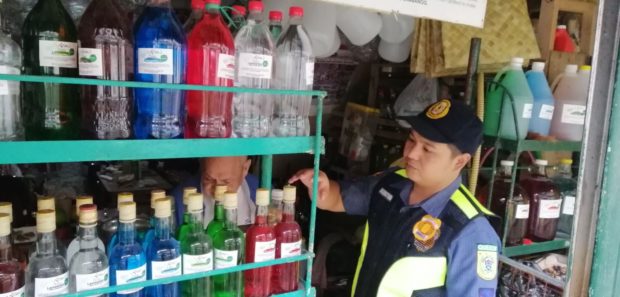
DEADLY DRINK? A cop inspects a store selling “lambanog,” a local coconut wine, following an outbreak of suspected methanol poisoning in Quezon province. —PHOTO COURTESY OF QUEZON PNP
The Food and Drug Administration (FDA) on Wednesday found traces of methanol in samples of “lambanog” (coconut wine) collected from stores or distributors that were said to be responsible for the death of 14 people and the hospitalization of close to 500 others in Laguna and Quezon provinces.
Methanol, also called methyl alcohol, wood alcohol, wood spirits and carbinol, is commonly used as a solvent or fuel and is even found in household products, such as varnish and antifreeze.
While a small amount of methanol is present in alcoholic drinks, as a byproduct of fermentation, this should not exceed, for instance 10-220 milligrams per liter in spirit drinks, otherwise it becomes toxic to humans.
The FDA said five of seven lambanog samples collected contained “11.4 to 18.2 percent” of methanol.
“This is considered toxic,” said Health Undersecretary Rolando Enrique Domingo, also FDA officer in charge.
“Very low levels of methanol may be present in alcoholic beverages provided they are byproducts of natural fermentation. The high levels found in the samples make them toxic,” Domingo said.
“Ingestion of 30 ml is potentially fatal. Absorption through the skin or via inhalation may also lead to toxic effects. This is due to methanol being converted to formaldehyde and formic acid in the liver,” he said.
Poisoning
The FDA said the lambanog samples tested were among those sold by Rey Lambanog, Emma’s Lambanog store and Orlando Mapa store.
Eleven people from Rizal and Nagcarlan towns in Laguna and three from Candelaria town in Quezon had died after drinking the local brew.
Health Secretary Francisco Duque III said charges would be filed against the manufacturer of the deadly lambanog.
In 2018, the FDA imposed a fine of P1.9 million and filed administrative cases against the operators and owners of a lambanog distillery also in Laguna.
“Despite the fact that they know what happened last year, then they should have exercised prudence and made sure that their products would undergo certificate of product registration process by the FDA,” Duque said.How methanol found its way into the coconut wine was something authorities were still figuring out, said Laguna health officer Rene Bagamasbad.
But lambanog makers like Angelito Campang, 55, from San Juan, Batangas, and Lito Mallari from Tayabas, Quezon, blamed unscrupulous distributors for illicitly mixing the chemical into the drink.
“The real lambanog is from distilled coconut spirit and not from the mixture of different chemicals, most of them toxic,” Mallari said.
Local tequila
Campang said real lambanog is so pure and naturally fermented it could match Mexico’s tequila.
Mallari said he was worried the recent incidents might hurt the industry especially as there was a huge demand for lambanog not only locally but also in the United States.
Campang blamed sellers who make up their own mix to speed up the process and satisfy the local demand for lambanog.
He said this is done by mixing very small amounts of coconut sap into water, formalin, ethanol, saccharin (as artificial sweetener) and methanol.
Others tweak the recipe by adding food coloring, although this is not harmful, Campang said.
More potent
Adding the chemicals, for instance the methanol, increases the drink’s alcohol level way faster than natural fermentation, therefore making it “matapang” (more potent), he said.
With jeeploads of lambanog delivered to Rizal town just before the poisoning, Campang said he believed dealers went too far in making the counterfeit lambanog.
“You cannot produce that much lambanog. I have a 2-hectare farm planted to coconuts and I can only make about 9 to 12 gallons (of pure sap) in a day,” he said.
Quezon Gov. Danilo Suarez disputed reports that the lambanog that killed 14 people was produced from the province.
“The report was malicious. The provincial government is very protective of our lambanog industry. We won’t tolerate unscrupulous local producers around,” he said.